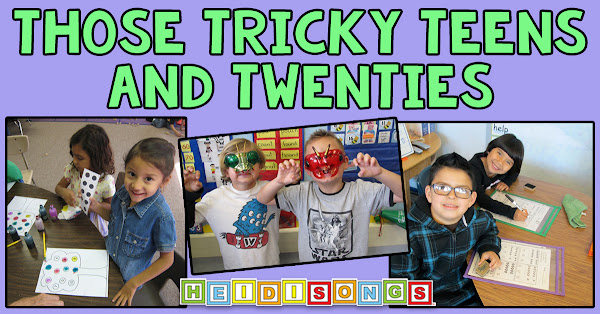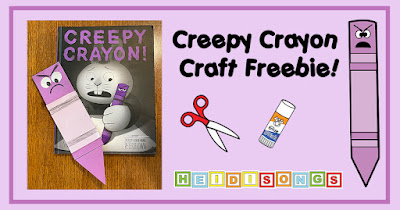Those Tricky Teens and Twenties
Have you heard the news? We've Moved to HeidiSongs.tv!
Our new website features an online video streaming service, updated blog posts at Heidisongs.blog, and a wealth of fresh resources designed to make learning even more fun and engaging.
You can also continue shopping for our educational products there and at our Teachers Pay Teachers store!
Head over to HeidiSongs.tv now and explore all the exciting new features.
See you there!
__________________________________________________________________________
1. Ten Frames and Counters

"Ten Frames" can help develop a sense of "ten-ness" at a glance. Give the children one with a completed ten and another one with a five to form 15. Have the children look at the ten frames and try to put that many objects into a modified egg carton that has just ten spaces- five on each side, plus another five in a bowl or paper plate. Then have them find number 15 on a flashcard and match it, for example. You can download ten frames, free, right here!!.

Instead of the egg cartons, you can get the CounTEN Sorting Cartons. Ice cube trays with ten spaces also work great. Sometimes these can be found at the Dollar Store. Change the objects with the seasons or the units of study, or change them with the holidays. We use small sea animals, zoo animals, insects, Chirstmas counters, Valentine’s Day counters, cereal, pom-poms, etc.
Last year I blogged about several other similar types of activities that can be done with other seasonal recording sheets and matching manipulatives, including The Number Tree, (Vanessa Levin’s idea but with my downloadable tree), Pumpkin Patch Counting, and Spider Web Counting. You can find the masters and write ups for each of these activities by following the links provided.
2. Pattern Block Numbers and Rubber Stamps

Another fun activity is to print out the black and white version of the Number Pattern Blocks and have the children glue down some paper pattern blocks in the spaces to decorate them. Then, have them try to stamp the correct number of objects above the numeral.

This can be tricky though for the children who just LOVE to go crazy with the stamps and start stamping out as many impressions as they can and subsequently wind up with way too many. I had them try for ten and circle them, and then add three more, for example, to get number 13. If you can afford it, a better way to do this might be to use stickers, because they are more easily removed if the children lay down too many. We just wound up having the children cross out the “extra” objects that they mistakenly stamped. Number Pattern Blocks available for purchase at HeidiSongs.com; just follow this link. Also printed in black and white for gluing down the printable paper pattern blocks and then stamping the correct numbers at the top.
3. Matching Sets with the Teens and Twenties

Have children match the numbers to the sets by finding groups of ten and counting on from there. I taught them to say, “TEN! Eleven, twelve, thirteen....” etc. I put some Place Value Practice Cards on a pocket chart and practiced counting on from 10 with the kids whole group for a minute or two each day after we did the calendar for a couple of weeks. This REALLY helped a lot, and it makes sense that it would! (For a free download of these cards, just follow the above link and scroll down.) Research does support short, daily practice sessions to acquire a new skill. It took about two weeks for most of the children to master it. I simply asked them over and over, “How many are in a box?” “How many are in a box?” And the children would answer, “Ten!” every time.
4. Stepping Stones Numbers


Combine motor development with math or language arts by writing numbers or words on “Stepping Stones” and have the kids step on them and identify the numbers as they go along. These are really called “Rigid Dome Cones” and are sold on Amazon. They also sell "Soft Dome Cones that collapse under the feet, but I haven't tried those. With the rigid ones, you get 36 of them for $46.48.

My kids LOVED to do this during our motor development time in small groups out on the grass, or during our after school tutoring inside on the carpet. A soft surface to play on IS important because they will fall off of them occasionally, although as you can tell by the little Facebook video of this activity I uploaded, the kids sure don't seem to care!
5. Transferring Number Skills to Paper

After that, I had them match these cards to the correct numerals in the teens or twenties either alone or in pairs. Once they had it, we tried to transfer it to paper. Check out the free download of the Christmas Tree Match Sets Cards and the Match Sets Worksheets with the Clearboards for more activities to work on this transfer.
6. Singing the Number Songs as a Transitional Activity
Virtually every single day in my classroom, we sing songs as we are transitioning from one activity to another. This helps get the blood moving through the body and sends oxygen to the brain to help prep the kids for their next lesson. It also makes the room a happier place, and gives the children a reason and permission to move. Did you know that happy children learn more? It’s a fact! And using my HeidiSongs.tv Video Streaming Site makes it SO easy!
7. Sing Along Songbooks for the Number Songs in a Listening Center

You can incorporate literacy into your math lessons by making song books with the song lyrics. You can download them for free here, or you can type them up yourself by copying the words to the songs. This makes a nice listening center. Some teachers have told me that they even use individual iPads or laptops and show the videos at their listening centers with headphones! The children are to write the words or numbers as the songs play.
* Write the Numbers While the Video Plays
I try to find time for this activity, but we really wind up doing it more often with the sight word videos than for the Number videos. One year when I had a little girl who by February was still missing numbers 12 and 20, I sent home the numbers DVD with her (back when we sold DVDs). I gave her the assignment to watch it each night for a week and write the numbers after each song. I also noticed that her parents wrote the numbers on her binder and also pinned them to her backpack, so they were probably just looking for ways to ask her to identify the numbers several times a day, which is another great suggestion to give parents. When her parents felt she knew the numbers, they sent it back.
Our new version of Number Jumble also includes numbers 11-30, available on our HeidiSongs.tv Video Streaming Site!
8. Provide a Little Motivation

Another year, a little boy's mom devised a reward system like this, and it really worked: she bought him a special t-shirt he really wanted, and safety pinned the numbers to it. She tacked the shirt to the wall in her hallway. Each time they walked by, she asked him the numbers. When she felt he knew each number, she took it off the shirt. When the shirt had no more numbers pinned to it, he got to wear it! I have suggested this to parents who ask me for ideas to help their children learn at home.
9. The Number Club

Make a chart and put it on your wall. As the children master all of the numbers from 0-30, (or whatever your goal is,) then let them write their name on that chart as a reward. Children enjoy seeing their names up on charts like this! We have had a Counting to 100 club, and a Letter Sounds club as well in past years. I am including my Number Club master as a free download for you today! To use it, all you have to do is mount it to the top half of a standard size piece of construction paper. Then, as the children meet their goal, let them write their names on the bottom half of the construction paper chart, under the Number Club Master. I laminated mine so that all I have to do is just tape it to a fresh piece of construction paper for the kids to write their names on when they reach the goal.
10. What if they are STILL not getting it?
Make your kids NEED the numbers and have to use them!

Line up by standing on words or numbers.
1. Number your chairs and pencils, and have the children find certain ones that they must use each day when they sit down at your command.
2. Number your carpet squares and/or line-up spots and have them go to certain ones. If they need to know the numbers, they will learn them.
I saw this idea posted by a teacher on the Teachers.net Kindergarten Chatboard once a couple of years ago, and while I have never needed to go to such lengths, I always thought that it was clever and made perfect sense.
* For More Great Ideas on Place Value in General:
Here's a link to a blog that did a summer book study on Debbie Diller's Math Stations book. I have only had a chance to take a quick glance, but it looks like it has some great ideas for further work on this topic at the first grade level and up! The blog is called "Oceans of First Grade Fun" and it is written by Yolanda Adams. I have also heard that Kim Sutton's book, called Place Value with Pizzazz is absolutely wonderful, but I haven't had a chance to read that one yet.
I hope you got some good ideas for teaching those tricky teen numbers!
----------------------------------
Follow me! Did you enjoy this post? Do me a favor and share it with your friends! And follow this blog by signing up for my email updates here, or follow on Bloglovin', or follow me on TPT! I'm also on Pinterest, Facebook, Twitter, Instagram, Google+ and YouTube, too! Don't forget to sign up for our email newsletter for special deals and promo codes that you won't find out about anywhere else.
I try to find time for this activity, but we really wind up doing it more often with the sight word videos than for the Number videos. One year when I had a little girl who by February was still missing numbers 12 and 20, I sent home the numbers DVD with her (back when we sold DVDs). I gave her the assignment to watch it each night for a week and write the numbers after each song. I also noticed that her parents wrote the numbers on her binder and also pinned them to her backpack, so they were probably just looking for ways to ask her to identify the numbers several times a day, which is another great suggestion to give parents. When her parents felt she knew the numbers, they sent it back.
Our new version of Number Jumble also includes numbers 11-30, available on our HeidiSongs.tv Video Streaming Site!
8. Provide a Little Motivation

Another year, a little boy's mom devised a reward system like this, and it really worked: she bought him a special t-shirt he really wanted, and safety pinned the numbers to it. She tacked the shirt to the wall in her hallway. Each time they walked by, she asked him the numbers. When she felt he knew each number, she took it off the shirt. When the shirt had no more numbers pinned to it, he got to wear it! I have suggested this to parents who ask me for ideas to help their children learn at home.
9. The Number Club

Make a chart and put it on your wall. As the children master all of the numbers from 0-30, (or whatever your goal is,) then let them write their name on that chart as a reward. Children enjoy seeing their names up on charts like this! We have had a Counting to 100 club, and a Letter Sounds club as well in past years. I am including my Number Club master as a free download for you today! To use it, all you have to do is mount it to the top half of a standard size piece of construction paper. Then, as the children meet their goal, let them write their names on the bottom half of the construction paper chart, under the Number Club Master. I laminated mine so that all I have to do is just tape it to a fresh piece of construction paper for the kids to write their names on when they reach the goal.
10. What if they are STILL not getting it?
Make your kids NEED the numbers and have to use them!

1. Number your chairs and pencils, and have the children find certain ones that they must use each day when they sit down at your command.
2. Number your carpet squares and/or line-up spots and have them go to certain ones. If they need to know the numbers, they will learn them.
I saw this idea posted by a teacher on the Teachers.net Kindergarten Chatboard once a couple of years ago, and while I have never needed to go to such lengths, I always thought that it was clever and made perfect sense.
* For More Great Ideas on Place Value in General:
Here's a link to a blog that did a summer book study on Debbie Diller's Math Stations book. I have only had a chance to take a quick glance, but it looks like it has some great ideas for further work on this topic at the first grade level and up! The blog is called "Oceans of First Grade Fun" and it is written by Yolanda Adams. I have also heard that Kim Sutton's book, called Place Value with Pizzazz is absolutely wonderful, but I haven't had a chance to read that one yet.
I hope you got some good ideas for teaching those tricky teen numbers!
Follow me! Did you enjoy this post? Do me a favor and share it with your friends! And follow this blog by signing up for my email updates here, or follow on Bloglovin', or follow me on TPT! I'm also on Pinterest, Facebook, Twitter, Instagram, Google+ and YouTube, too! Don't forget to sign up for our email newsletter for special deals and promo codes that you won't find out about anywhere else.









